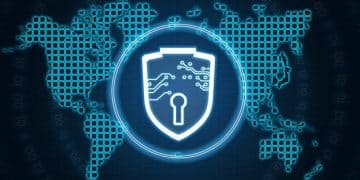Defense Industry Cybersecurity: 3 Steps to Comply with Updated Federal Regulations by January 2026

The evolving landscape of federal regulations requires the US defense industry to implement robust cybersecurity measures by January 2026, mandating a proactive, multi-faceted approach to safeguard sensitive information and critical infrastructure against sophisticated cyber threats.
In the intricate world of national security, the integrity of information is paramount, a constant race against relentless and increasingly sophisticated adversaries. For the defense industry, the stakes are exceptionally high, with every piece of digital data representing a potential vulnerability. The impending January 2026 deadline for updated federal cybersecurity regulations casts a long, urging shadow, demanding immediate and strategic action from defense contractors and every entity within the defense industrial base (DIB). This evolving regulatory environment is not merely about compliance; it’s a critical imperative for safeguarding national security and ensuring operational continuity against an ever-present digital threat.
The Evolving Threat Landscape in Defense Cybersecurity
The defense industry operates at the forefront of technological innovation and geopolitical strategy, making it an irresistible target for state-sponsored actors, cybercriminals, and activist groups. The motivations are diverse—ranging from intellectual property theft and espionage to sabotage and disruption of critical defense capabilities. Understanding this continuously evolving threat landscape is the foundational first step in building an effective cybersecurity posture that goes beyond mere compliance.
Cyber adversaries employ a sophisticated array of tactics, techniques, and procedures (TTPs), constantly adapting to exploit new vulnerabilities and bypass existing defenses. Phishing campaigns, ransomware attacks, supply chain compromises, and zero-day exploits are just a few examples of the methods used to penetrate defense networks. The sheer volume and complexity of the data held by defense contractors—from classified research and development to sensitive personnel information—make these organizations prime targets for persistent and well-resourced attackers.
Understanding Advanced Persistent Threats (APTs)
Advanced Persistent Threats (APTs) represent perhaps the most formidable challenge for defense cybersecurity. These are typically state-sponsored or highly organized criminal groups that engage in long-term, sophisticated, and targeted cyberattacks. Unlike opportunistic attacks, APTs are characterized by their stealth, persistence, and ability to adapt to defensive measures, often residing undetected within a network for extended periods to exfiltrate data or prepare for future disruptive operations.
- Stealth and Evasion: APTs often use custom malware, polymorphic code, and advanced obfuscation techniques to avoid detection by traditional security tools.
- Patience and Persistence: They are willing to invest significant time and resources to achieve their objectives, often re-engaging even after initial detection and removal attempts.
- Targeted Reconnaissance: Before launching an attack, APTs extensively research their targets, tailoring their approach to exploit specific weaknesses within the victim’s infrastructure and personnel.
The implications of a successful APT attack on the defense industry can be catastrophic, leading to the loss of sensitive military plans, technological advantages, or critical intelligence, directly impacting national security. Therefore, a proactive and intelligence-driven approach to cybersecurity, capable of identifying and mitigating APTs, is essential.
The Expanding Attack Surface
The increasing interconnectedness of systems, reliance on cloud services, the proliferation of IoT devices, and the complex web of supply chain dependencies have dramatically expanded the attack surface for defense organizations. Each new technology and every third-party vendor introduces potential vulnerabilities that can be exploited by adversaries.
Historically, cybersecurity focused primarily on perimeter defense. However, with modern hybrid environments, the perimeter has become increasingly porous, making a “zero trust” architecture critical. This approach assumes that no user or device, whether inside or outside the network, should be trusted by default. Instead, every access attempt is verified, drastically reducing the chances of lateral movement by an attacker following an initial breach.
The rapid adoption of new technologies, while providing significant operational advantages, often outpaces the development and implementation of robust security controls. This gap creates windows of opportunity for adversaries who are quick to exploit unpatched systems, misconfigured cloud environments, or insecure IoT devices. Defense contractors must prioritize security from the earliest stages of technology adoption and maintain continuous monitoring and vulnerability management programs.
In conclusion, the defense industry’s cybersecurity landscape is turbulent, defined by persistent and sophisticated threats, an expanding attack surface, and the imperative to protect highly sensitive information. A deep understanding of these dynamics is the critical first step towards compliance with updated federal regulations and, more importantly, securing the nation’s defense capabilities.

Step 1: Understand the Regulatory Landscape and Assess Current Gaps
The journey towards robust Defense Industry Cybersecurity: 3 Steps to Comply with Updated Federal Regulations by January 2026 begins with a thorough understanding of the regulatory environment and an honest assessment of an organization’s current security posture. Navigating the complex web of federal requirements, primarily driven by the Department of Defense (DoD), demands precision and a comprehensive approach.
The primary regulatory framework governing cybersecurity for defense contractors is the Cybersecurity Maturity Model Certification (CMMC). CMMC is designed to ensure that defense contractors and their supply chain partners adequately protect sensitive unclassified information, especially Controlled Unclassified Information (CUI). While CMMC has undergone several iterations, CMMC 2.0 is the current version and serves as the backbone of the DoD’s approach to cybersecurity.
Decoding CMMC 2.0 Requirements
CMMC 2.0 streamlines the previous CMMC model, focusing on three key levels, each corresponding to different types of information and associated risks. Understanding which level applies to your organization is paramount, as it dictates the specific cybersecurity practices and processes that must be implemented.
- Level 1: Foundational: For companies that only handle Federal Contract Information (FCI). Requires annual self-assessment against 15 practices from NIST SP 800-171, Appendix D.
- Level 2: Advanced: For companies handling Controlled Unclassified Information (CUI). Requires annual self-assessment for non-prioritized acquisitions and triennial third-party assessments for prioritized acquisitions against 110 practices aligned with NIST SP 800-171.
- Level 3: Expert: For companies handling CUI on DoD’s most critical programs. Requires triennial government-led assessments against a subset of NIST SP 800-172 practices.
The shift from CMMC 1.0 to 2.0 emphasizes a tiered approach, reducing complexity for some contractors while reinforcing the need for rigorous third-party assessments for those handling the most sensitive CUI. Compliance involves not only implementing technical controls but also establishing mature processes and documentation to demonstrate adherence.
Conducting a Comprehensive Gap Analysis
Once the relevant CMMC level is determined, the next critical step is to conduct a detailed gap analysis. This involves comparing your organization’s current cybersecurity practices against the specific requirements outlined in the CMMC model and NIST SP 800-171 (and possibly NIST SP 800-172 for Level 3). A thorough gap analysis provides a clear roadmap for remediation efforts.
The process should be objective and involve cross-functional teams, including IT, security, legal, and operational staff. Key areas to assess include:
Technical Controls: Evaluate the effectiveness of firewalls, intrusion detection/prevention systems, access controls, encryption, patch management, and security information and event management (SIEM) solutions. Are these controls configured optimally and maintained consistently?
Policies and Procedures: Review existing security policies, incident response plans, data handling procedures, and employee training programs. Are they up-to-date, comprehensive, and actively enforced? Are roles and responsibilities clearly defined for cybersecurity tasks?
Documentation: CMMC places significant emphasis on documented evidence of compliance. Assess whether all required policies, procedures, system security plans (SSPs), and plans of action and milestones (POA&Ms) are in place, accurate, and regularly reviewed.
Supply Chain Security: Your organization is only as strong as its weakest link. Assess the cybersecurity posture of your critical suppliers and subcontractors. Do they also comply with relevant CMMC levels? This often requires contractual clauses and ongoing monitoring.
The outcome of the gap analysis should be a detailed report outlining identified deficiencies, their severity, and recommendations for remediation. This becomes the foundation for developing a strategic action plan, prioritizing efforts, and allocating necessary resources to achieve compliance by the January 2026 deadline.
In essence, understanding the regulatory landscape and performing a meticulous gap analysis are not just bureaucratic exercises; they are strategic imperatives that lay the groundwork for a resilient cybersecurity framework, embedding protection deep within the operational fabric of defense organizations.
Step 2: Implement and Fortify Technical and Procedural Controls
With a clear understanding of the regulatory landscape and identified gaps, the second crucial step in achieving robust Defense Industry Cybersecurity: 3 Steps to Comply with Updated Federal Regulations by January 2026 is the actual implementation and fortification of technical and procedural controls. This phase moves beyond theoretical understanding to practical application, embedding security measures throughout the organization’s infrastructure and culture.
The core of this step involves enhancing existing systems and introducing new capabilities to meet the stringent requirements of CMMC 2.0. This isn’t a one-time fix but an ongoing commitment to a dynamic security posture.
Strengthening Technical Safeguards
Technical controls form the bedrock of any effective cybersecurity program. For defense contractors, these must be rigorously applied and continuously monitored. The NIST SP 800-171 guidelines, which CMMC 2.0 heavily references, provide a detailed blueprint for these safeguards.
Access Control and Authentication: Implement strong access controls, ensuring that only authorized personnel have access to sensitive information. This includes multi-factor authentication (MFA) for all accounts, least privilege principles, and robust identity management systems. Regularly review access rights and promptly revoke access for departing employees or changing roles.
Incident Response Planning: Develop and regularly test a comprehensive incident response plan. This plan should detail procedures for detecting, containing, eradicating, and recovering from cyber incidents. Regular drills and tabletop exercises are vital to ensure the plan’s effectiveness and to train personnel on their roles during a crisis.
Network and System Security: Fortify network defenses with next-generation firewalls, intrusion detection and prevention systems (IDPS), and robust endpoint detection and response (EDR) solutions. Implement strict patch management policies to ensure all systems and applications are up-to-date, closing known vulnerabilities. Segment networks to limit lateral movement by attackers.
Data Encryption: Ensure that all Controlled Unclassified Information (CUI) is encrypted both in transit and at rest. This provides a critical layer of protection in case of a breach, rendering the data unreadable to unauthorized parties. Implement strong encryption protocols and manage encryption keys securely.
Security Information and Event Management (SIEM): Deploy and effectively utilize SIEM solutions to aggregate and analyze security logs from across the IT environment. This enables real-time threat detection, provides valuable insights into network activity, and supports forensic investigations following an incident.
Implementing Robust Procedural Controls and Training
While technical controls are essential, they are only as effective as the human element and the processes that govern their use. Procedural controls and a strong security culture are indispensable for comprehensive cybersecurity.
Security Awareness Training: Human error remains a significant vulnerability. Implement mandatory, regular security awareness training for all employees, emphasizing topics such as phishing recognition, safe browsing practices, data handling protocols, and the importance of reporting suspicious activities. Tailor training to different roles within the organization.
Supply Chain Risk Management: Extend cybersecurity diligence to the entire supply chain. Implement vetting processes for third-party vendors and contractors, ensuring they meet the required CMMC levels. Include cybersecurity clauses in contracts and conduct periodic audits of vendor security postures. This protects against supply chain attacks, a growing vector for breaches.
Documentation and Policy Enforcement: Maintain accurate and up-to-date documentation for all security policies, procedures, system security plans (SSPs), and plans of action and milestones (POA&Ms). Ensure these documents reflect actual practices and are accessible to relevant personnel. Regularly audit compliance with these policies and enforce them consistently.
Data Loss Prevention (DLP): Implement DLP solutions to prevent sensitive information from leaving the organization’s control without authorization. DLP systems can monitor, detect, and block the unauthorized transmission of CUI through various channels, including email, cloud storage, and removable media.
The implementation phase is resource-intensive, requiring significant investment in technology, personnel, and training. However, it is a non-negotiable step in building a resilient defense against cyber threats and ensuring compliance with the updated federal regulations. A holistic approach that integrates technical solutions with strong policies and an informed workforce is crucial for success.
Step 3: Continuous Monitoring, Auditing, and Adaptation
Achieving compliance by January 2026 is not a static endpoint but the beginning of an ongoing commitment to cybersecurity. The third and perhaps most critical step for Defense Industry Cybersecurity: 3 Steps to Comply with Updated Federal Regulations by January 2026 involves establishing mechanisms for continuous monitoring, regular auditing, and agile adaptation to emerging threats and evolving regulatory requirements. The cyber landscape is dynamic; therefore, a static security posture is inherently insecure.
This final step ensures that the cybersecurity measures implemented are not only effective today but remain resilient and relevant in the face of future challenges. It transforms compliance from a one-time project into an embedded, perpetual organizational capability.
Establishing Continuous Monitoring Capabilities
Continuous monitoring is essential for identifying potential vulnerabilities, detecting security incidents in real-time, and ensuring that security controls remain effective. It involves a systematic and ongoing review of an organization’s information systems and networks.
- Vulnerability Management:
- Regularly conduct vulnerability scans and penetration testing to identify weaknesses in systems, applications, and networks. Promptly address any identified vulnerabilities through patching, configuration changes, or other remediation steps. Prioritize remediation based on the severity of the vulnerability and its potential impact on CUI.
- Threat Intelligence Integration:
- Integrate real-time threat intelligence feeds into your security operations. This provides information on emerging threats, attack vectors, and adversary TTPs, enabling proactive adjustments to defenses. Sharing threat intelligence within the defense industrial base and with government agencies can enhance collective security.
- Security Log Analysis:
- Leverage SIEM and security automation tools to continuously collect, analyze, and correlate security logs from all relevant systems and devices. This enables the detection of anomalous activities, failed login attempts, unauthorized access attempts, and other indicators of compromise (IOCs).
Effective continuous monitoring provides early warning signs of an attack, reduces the time to detect and respond to incidents, and helps ensure that security controls are functioning as intended. It shifts the security paradigm from reactive to proactive.
Regular Auditing and Assessment for Compliance
Beyond continuous monitoring, periodic internal and external audits are indispensable for verifying compliance and identifying areas for improvement. These assessments validate the effectiveness of your security program against CMMC 2.0 requirements and other applicable regulations.
Internal Audits: Conduct regular internal audits by independent cybersecurity teams or qualified personnel. These audits should rigorously assess adherence to established policies, procedures, and technical controls. Document all findings, including non-conformities, and track remediation efforts through a Plan of Action and Milestones (POA&M).
Third-Party Assessments: For CMMC Level 2 and Level 3, external third-party assessments (or government-led assessments for Level 3) are mandated. Prepare meticulously for these assessments by ensuring all documentation is current, controls are operational, and personnel are ready to demonstrate compliance. Treat these assessments as opportunities for external validation and improvement.
Tabletop Exercises and Simulations: Periodically conduct cybersecurity tabletop exercises and full-scale simulations. These drills test the incident response plan, evaluate team readiness, and identify gaps in processes or communication. Lessons learned from these exercises should inform improvements to the security program.
The results of audits and assessments provide objective evidence of compliance while highlighting areas requiring further attention. They are crucial for maintaining accreditation and demonstrating due diligence to federal agencies.
Adapting to Evolving Threats and Regulations
The cybersecurity landscape never stands still. New threats emerge, technologies evolve, and regulations are updated. A resilient cybersecurity program must be designed for continuous adaptation.
Staying Informed: Regularly monitor official DoD and NIST publications, industry best practices, and threat intelligence reports. Subscribing to relevant government alerts and participating in industry forums can keep your organization apprised of the latest developments.
Security by Design: Integrate security considerations into every phase of the system development lifecycle (SDLC) and technology adoption. This “security by design” approach helps to build resilience from the ground up, reducing the cost and complexity of retrofitting security later.
Investment in Training and Technology: Continuously invest in professional development for your cybersecurity team to keep their skills sharp and current. Similarly, upgrade and acquire new security technologies as needed to counter evolving threats and support new operational requirements.
By embracing a culture of continuous improvement, defense contractors can not only meet the January 2026 compliance deadline but also build a robust, adaptive, and future-proof cybersecurity posture essential for safeguarding national security interests.
Beyond Compliance: Building a Resilient Cyber Ecosystem
While the January 2026 deadline for updated federal regulations, particularly CMMC 2.0, provides a clear imperative for Defense Industry Cybersecurity: 3 Steps to Comply with Updated Federal Regulations by January 2026, success in this domain transcends mere compliance. The true objective is to foster a resilient cyber ecosystem within each defense organization and across the entire Defense Industrial Base (DIB). This involves viewing cybersecurity not as a cost center or a checkbox exercise, but as a fundamental pillar of operational integrity and national security.
A resilient cyber ecosystem is one that can anticipate, withstand, recover from, and adapt to adverse cyber conditions. It requires a holistic fusion of technology, people, processes, and continuous intelligence.
Fostering a Culture of Cybersecurity
Technology and robust processes are vital, yet the human element remains the weakest link if not properly addressed. Cultivating a pervasive culture of cybersecurity within an organization is paramount. This goes beyond annual training; it involves integrating security principles into daily operations and decision-making at every level.
- Leadership Buy-in: Cybersecurity must be championed from the top down. Leadership must consistently communicate its importance, allocate necessary resources, and lead by example in adhering to security protocols. When leaders prioritize security, the entire organization follows suit.
- Empowering Employees: Ensure that all employees understand their role in maintaining cybersecurity. Provide continuous, engaging training that goes beyond basic awareness to address specific threats relevant to their daily tasks. Encourage a “see something, say something” mentality regarding suspicious activities.
- Integrated Security Teams: Break down silos between IT, operations, and security teams. Foster collaboration and shared responsibility for security outcomes. Embed security professionals within development and operational teams to promote security by design.
Transforming cultural habits takes time and consistent reinforcement, but the payoff is immense: a workforce that acts as a proactive defense rather than a passive vulnerability.
Integrating Cyber Resilience into Business Strategy
Cybersecurity should not be an afterthought but an integral part of an organization’s overall business strategy. This means considering cyber risks in strategic planning, investment decisions, and operational execution. Defense contractors must recognize that their competitive advantage increasingly hinges on their ability to protect sensitive data and maintain operational continuity in a hostile cyber environment.
Risk Management Frameworks: Implement a comprehensive risk management framework that identifies, assesses, mitigates, and monitors cyber risks continuously. Quantify potential impacts of cyber incidents on critical business functions and national security missions to prioritize investments effectively.
Supply Chain Partnership: Rather than simply dictating compliance to suppliers, defense organizations should cultivate genuine cybersecurity partnerships with their supply chain. This might involve sharing best practices, offering guidance, or even collaborating on threat intelligence. A strong, secure supply chain is a mutual benefit, enhancing collective resilience.
Innovation and Emerging Technologies: As defense capabilities become more reliant on emerging technologies like Artificial Intelligence (AI), Machine Learning (ML), quantum computing, and the Internet of Things (IoT), integrate security considerations from the outset. Early adoption of “security by design” principles in these nascent areas can prevent costly retrofits and mitigate new attack vectors.
Ultimately, a resilient cyber ecosystem is characterized by its agility and adaptability. It understands that threats are constantly evolving, and thus, its defenses must evolve alongside them. This proactive stance not only ensures compliance but also enhances an organization’s ability to fulfill its vital role in national defense, securely and effectively.
Operationalizing Compliance: Tools and Best Practices
Operationalizing the steps to achieve Defense Industry Cybersecurity: 3 Steps to Comply with Updated Federal Regulations by January 2026 requires more than just understanding the requirements; it demands practical application through appropriate tools, robust processes, and the adoption of industry best practices. Merely having policies in place is insufficient; they must be actionable, auditable, and integrated into daily operations.
This section delves into specific strategies and technologies that defense contractors can leverage to move from theoretical compliance to a state of continuous operational security and resilience.
Leveraging Automation for Efficiency and Accuracy
Manual processes are prone to human error and can be incredibly time-consuming, especially in large, complex environments. Automation can significantly enhance the efficiency and accuracy of cybersecurity operations, supporting compliance efforts.
- Automated Vulnerability Scanners: Deploy tools that automatically scan networks, applications, and systems for vulnerabilities. Integrate these scanners with patch management systems to automate remediation where possible.
- Security Orchestration, Automation, and Response (SOAR): SOAR platforms can automate repetitive security tasks, orchestrate incident response workflows, and provide centralized management of security operations. This reduces response times and lessens the burden on security analysts.
- Configuration Management Tools: Use tools that enforce consistent and secure configurations across all IT assets. These tools can automatically detect and revert unauthorized changes, ensuring continuous adherence to security benchmarks.
By automating routine security tasks, organizations can free up their security personnel to focus on more complex threat analysis, strategic planning, and security architecture, ultimately leading to a more robust and efficient security posture.
Adopting a Zero Trust Architecture (ZTA)
The traditional “trust but verify” model, where everything inside the network perimeter is implicitly trusted, is no longer viable in the face of sophisticated threats and a dispersed workforce. A Zero Trust Architecture (ZTA) operates on the principle of “never trust, always verify,” significantly enhancing security.
- Micro-segmentation:
- Break down networks into smaller, isolated segments. This limits the lateral movement of attackers even if they manage to breach an initial point of entry, containing the scope of a potential attack.
- Strict Access Controls:
- Implement granular, context-aware access controls for every user and device accessing resources. Access is granted based on identity, device posture, location, and other attributes, and it is continuously re-evaluated.
- Continuous Verification:
- Assume breach at all times. Every access request, regardless of origin, is verified. This includes multi-factor authentication (MFA) at every access point and continuous monitoring of user behavior.
Implementing ZTA is a complex undertaking that requires significant planning and investment, but it provides a superior level of security, particularly for protecting CUI and critical defense systems against insider threats and advanced external attackers.
Best Practices for Data Protection and Incident Response
Effective data protection and a well-honed incident response capability are cornerstones of operational cybersecurity. Adhering to specific best practices ensures that sensitive information is safeguarded and that the organization can swiftly recover from any cyber adversity.
Data Classification and Labeling: Accurately classify and label all data, especially CUI, to ensure appropriate protection measures are applied. Implement data discovery tools to locate CUI across systems and repositories.
Regular Backups and Disaster Recovery: Implement comprehensive data backup strategies with offsite storage and immutable backups to protect against ransomware and data corruption. Develop and regularly test a disaster recovery plan to ensure business continuity after a major incident.
Proactive Threat Hunting: Go beyond passive monitoring by actively “hunting” for threats within your network. This involves leveraging threat intelligence and analytical skills to detect subtle or hidden indicators of compromise that automated tools might miss.
Post-Incident Review: After every significant security incident or near-miss, conduct a thorough post-mortem analysis. Identify root causes, evaluate the effectiveness of the response, and implement lessons learned to prevent future occurrences. This iterative process fosters continuous improvement.
Operationalizing compliance is about transforming policies into practices. By strategically deploying relevant tools, adopting advanced architectural models like Zero Trust, and committing to these best practices, defense contractors can build a robust, efficient, and highly defensible cybersecurity posture that stands ready to meet the demands of the federal regulations and the evolving threat landscape.
Preparing for Assessment and Sustained Compliance
As the January 2026 deadline for updated federal regulations like CMMC 2.0 approaches, preparing for formal assessment and ensuring sustained compliance become paramount for Defense Industry Cybersecurity: 3 Steps to Comply with Updated Federal Regulations by January 2026. This phase is about demonstrating not just capability, but also consistency and maturity in cybersecurity practices. It moves beyond implementing controls to proving their effectiveness and organizational commitment over time.
The journey doesn’t end with initial compliance; it transitions into a continuous cycle of verification, adaptation, and improvement to maintain accreditation and uphold national security standards.
The Assessment Process: What to Expect
For defense contractors at CMMC Level 2, a third-party assessment will be conducted by a CMMC Third-Party Assessment Organization (C3PAO). For Level 3, government-led assessments are required. Understanding the assessment process is crucial for effective preparation.
- Scope Definition: The C3PAO will work with your organization to define the scope of the assessment, identifying which systems, networks, and data are subject to CMMC requirements, particularly those handling CUI.
- Documentation Review: Assessors will meticulously review all relevant documentation, including your System Security Plan (SSP), Plans of Action and Milestones (POA&M), security policies, procedures, and evidence of implementation. This is often the first phase and can identify significant gaps.
- Interviews and Technical Testing: Assessors will conduct interviews with key personnel, from IT staff to senior management, to understand their roles and awareness of security practices. They will also perform technical testing, such as examining system configurations, reviewing audit logs, and observing security processes in action.
- Evidence Collection: Throughout the assessment, the C3PAO will collect evidence to determine whether your organization meets each CMMC practice and process. This evidence could include screenshots, meeting minutes, system logs, training records, and policy documents.
- Reporting and Remediation: Following the assessment, the C3PAO will provide a report detailing their findings, including any deficiencies. Organizations will then need to address these deficiencies and provide evidence of remediation before certification can be granted.
Preparation should ideally begin well in advance of the scheduled assessment, including pre-assessments and mock audits to identify and fix issues proactively.
Maintaining Sustained Compliance and Maturity
Achieving CMMC certification is a significant milestone, but sustained compliance requires ongoing effort and a commitment to cybersecurity maturity. The threat landscape, technologies, and regulations are constantly evolving, demanding continuous adaptation.
Regular Internal Audits and Reviews: Implement a robust internal audit schedule that goes beyond regulatory requirements. These regular reviews help to proactively identify weaknesses, ensure controls are operating effectively, and confirm that policies are being followed. Leverage feedback from employees and internal stakeholders to drive continuous improvement.
Continuous Training and Awareness: Keep cybersecurity training fresh and relevant. The content should evolve to address new threats, technologies, and regulatory changes. Consider advanced training for specialized roles and regular refreshers for all employees. A well-informed workforce is the first line of defense.
Adaptive Security Architecture: Design your security architecture to be flexible and scalable. This enables easier integration of new security tools, faster adoption of emerging technologies, and more agile responses to new threats or changes in business operations. Avoid rigid, siloed security solutions.
Performance Metrics and Reporting: Establish key performance indicators (KPIs) and metrics for your cybersecurity program. Regularly report on these metrics to leadership and relevant stakeholders. This demonstrates the effectiveness of security investments and provides data for strategic decision-making. Metrics could include incident response times, vulnerability patch rates, or compliance with security baselines.
Sustained compliance and security maturity are not about avoiding all risks, which is impossible, but about minimizing the attack surface, improving detection and response capabilities, and building resilience. By embedding these practices into the organizational DNA, defense contractors can not only meet federal mandates but also confidently protect critical national security assets into the future.
| Key Aspect | Brief Description |
|---|---|
| 📊 Understand Regulations | Familiarize with CMMC 2.0 levels and conduct thorough gap analysis against NIST 800-171. |
| 🛡️ Implement Controls | Strengthen technical safeguards (MFA, encryption) and procedural controls (training, supply chain). |
| 📈 Monitor Continuously | Establish ongoing monitoring, regular audits, and adaptation processes for sustained compliance. |
| 🤝 Build Resilience | Foster a cybersecurity culture and integrate risk management into overall business strategy. |
Frequently Asked Questions About Defense Industry Cybersecurity
CMMC 2.0 (Cybersecurity Maturity Model Certification) is a unified standard for implementing cybersecurity across the defense industrial base. It’s crucial because it ensures defense contractors and their supply chain protect sensitive unclassified information (CUI), making it a mandatory requirement for contracting with the DoD. Compliance is vital for protecting national security and maintaining eligibility for defense contracts.
CMMC 2.0 has three levels: Level 1 (Foundational) for Federal Contract Information (FCI), requiring annual self-assessments. Level 2 (Advanced) for Controlled Unclassified Information (CUI), requiring self-assessments or third-party assessments depending on acquisition priority. Level 3 (Expert) for critical CUI, demanding triennial government-led assessments. Each level mandates increasing cybersecurity practices and rigor.
Key steps include understanding the CMMC 2.0 requirements relevant to your organization’s data handling, conducting a thorough gap analysis against NIST SP 800-171, implementing and fortifying necessary technical and procedural controls, and establishing continuous monitoring, auditing, and adaptation processes. Proactive preparation and dedicated resources are essential for meeting the deadline.
Zero Trust Architecture (ZTA) enhances defense cybersecurity by abandoning the traditional perimeter-based security model. It operates on the principle of “never trust, always verify” for every user and device access request, regardless of location. This minimizes the attack surface, prevents lateral movement of adversaries within networks, and rigorously verifies identities, significantly bolstering protection for sensitive defense data.
Failure to comply with CMMC 2.0 by the deadline could result in significant penalties, including inability to bid on new DoD contracts requiring CMMC certification, loss of existing contracts, and potential legal repercussions. Non-compliance jeopardizes a contractor’s standing within the defense industrial base and can severely impact their business operations and reputation in the sector.
Conclusion
The impending January 2026 deadline for updated federal cybersecurity regulations represents a critical inflection point for the defense industry. More than a bureaucratic hurdle, it underscores the strategic necessity of robust cybersecurity as a foundational element of national security. By diligently navigating the three core steps—comprehending the evolving regulatory landscape and assessing current gaps, implementing and fortifying technical and procedural controls, and embracing continuous monitoring, auditing, and adaptation—defense contractors can not only achieve compliance but also cultivate a resilient cyber ecosystem. This proactive and comprehensive approach is indispensable for safeguarding sensitive information, mitigating increasingly sophisticated threats, and ensuring the continued operational integrity vital to the nation’s defense capabilities. The commitment to a secure digital environment is an ongoing imperative, a non-negotiable investment in a future where national security is intrinsically linked to cyber resilience.





